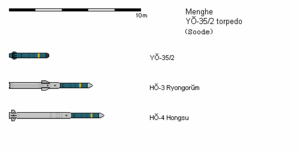HŎ-3 Ryongorŭm
| HŎ-3 Ryongorŭm | |
|---|---|
 | |
| Type | Anti-submarine missile |
| Place of origin | Menghe |
| Service history | |
| In service | 2007-present |
| Specifications | |
| Weight | 1,490 kg |
| Length | 6.30 m |
| Diameter | 350mm (nose) 490 mm (base) |
| Warhead | YŎ-35/2 torpedo |
| Engine | Two-stage solid-fuel rocket |
Operational range | 37 km |
Guidance system | Inertial guidance with mid-course update |
Launch platform | Surface ships |
The HŎ-3 Ryongorŭm ("waterspout") is a type of anti-submarine missile developed in Menghe during the 2000s as a replacement for the HŎ-2 Poksŏl. While the HŎ-2 is launched from torpedo tubes and fires its rocket engine in the water, the HŎ-3 launches directly into its airborne trajectory from the ship's vertical launching system. Its payload is a single YŎ-35/2 torpedo, which autonomously homes in on underwater targets.
Development
While the HŎ-2 brought a major improvement to Menghean anti-submarine capabilities when introduced in 1993, it had a number of serious drawbacks. Because the rocket motor ignites underwater, each missile launch produces a loud and distinct acoustic signature, alerting nearby submarines that they are being engaged and revealing the location of the launch platform. Furthermore, because the HŎ-2 is stored in the surface ship's torpedo tubes and competes for space with guided anti-submarine torpedoes, practical capacity is limited to 2-4 ready rounds per ship - leaving 4-6 guided heavyweight torpedoes.
Work on the HŎ-3 began in 1999, when Menghe began negotiations with Tír Glas over the licensing of the Mark 41 Vertical Launching System. It was planned that if the licensing deal failed, Menghe would proceed to develop the system for a domestically designed VLS family. In August 2001, however, Menghe signed an agreement with Dayashina relinquishing its claim to the Renkaku Islands, and the Mark 41 licensing deal went ahead.
Development was accelerated in 2005 after armed clashes with Sieuxerr and Anglia and Lechernt in the Ummayan Civil War increased the risk of war in the South Menghe Sea. A number of modern guided missile warships went to sea with HŎ-3 compatibility but no stored missiles. The first operational deliveries were reportedly made in 2007.
Description
Like other vertical-launch anti-submarine missiles, the HŎ-3 consists of a standard lightweight anti-submarine torpedo mounted on top of a solid-fuel booster. It is physically larger than the similar RUM-139 VL-ASROC, with a "stepped" fuselage at the end of the torpedo payload. This is partly to compensate for the 350mm YŎ-35/2 torpedo's higher weight, and partly to extend the system's range.
Once launched, the HŎ-3 rocket follows a ballistic trajectory toward its designated target area. It uses a simple inertial navigation system to minimize drift. While the missile is in the air, the launch platform can send it course-correction information via datalink, for example to adjust its trajectory against a submarine which suddenly changed course and accelerated. Otherwise, the missile is entirely autonomous once activated.
As the missile nears the end of its trajectory, a small explosive charge separates the torpedo payload from the missile body. Parachutes on both objects slow their descent, preventing damage to the torpedo as it impacts the ocean's surface and reducing splash noise which could alert the submarine below. Once it lands in the water, the YŎ-35/2 torpedo begins circling at low speed until it acquires an acoustic target. It completes its first two circles in passive mode, then switches to active mode if it cannot acquire a target. After a target is acquired, the torpedo autonomously homes in on it, automatically selecting a low-speed passive or high-speed active approach depending on the engagement circumstances.
Launch platforms
The HŎ-3 Ryongorŭm is designed to be launched from the Mark 41 Vertical Launching System on surface ships. Due to its size, the HŎ-3 can only be fired from "tactical-length" cells with a depth of 6.8 meters or "strike length" cells with a depth of 7.7 meters. A land-launched version using Navy vertical launch containers has been photographed undergoing testing, but it is not known whether it is operational. No submarine-launched or torpedo-tube-launched variant exists.
- Chanjok Jachido-class cruiser (after refits)
- Pyŏng'an-class destroyer (after refits)
- Haeju-class destroyer
- Ansa-class frigate (after refits)
- Hawŏn-class frigate (after refits)